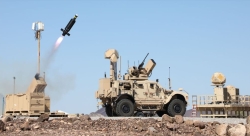DARPA’s Subterranean Challenge Aims to Find Breakthrough Technologies for Underground Ops

The U.S. Defense Advanced Research Projects Agency (DARPA)'s Subterranean (SubT) Challenge aims to better equip warfighters and first responders to explore uncharted underground environments such as in caves, tunnels or urban areas that are too dangerous, dark or deep to risk human lives.
The goal of the challenge was to find breakthrough technologies and capabilities for underground operations, Timothy Chung, DARPA program manager of the SubT Challenge, said.
Eight teams participated in the systems competition and nine teams competed in a virtual competition, deploying autonomous systems to map, navigate and search underground spaces. The challenge took place at the Louisville Mega Cavern in Louisville, Kentucky, Sept. 21 to 24.
There was $5 million in prizes in the final competition, including a $2 million prize for first place prize in the systems competition and a $750,000 prize for first place in the virtual competition.
Eight U.S. and international teams competed in the final systems competition event. The winner was CERBERUS, a collaboration effort involving two U.S. universities, four international universities and a Nevada corporation.
Twelve teams competed in the final virtual competition. The winner was Dynamo, a team based in Spain.
The systems competition involved robots and the virtual competition took place in simulated underground worlds. Four teams competed in both situations.
Teams earned points by correctly identifying artifacts placed within each environment.

Chung said the robots fielded by the systems teams quickly navigated unfamiliar underground environments in search of common items, including backpacks, cell phones, trapped "survivors" and invisible gas. Chung said the robots fielded by the systems teams quickly navigated unfamiliar underground environments in search of common items, including backpacks, cell phones, trapped "survivors" and invisible gas.
He said nine virtual teams submitted autonomy software solutions for exploring simulated underground worlds in search of similar items.
Roboticists and engineers from eleven countries participated in the final event of the challenge.
Chung said teams in the systems competition developed a wide variety of robotic systems to advance and evaluate novel mapping and navigation solutions.
Likewise, teams in the virtual competition were successful at developing software and algorithms using virtual models of systems, environments and terrain, he said.
"In time-sensitive missions, such as active combat operations or disaster response, warfighters and first responders face difficult terrain, unstable structures, degraded environmental conditions, severe communication constraints and expansive areas of operation," Chung said. "The [Subterranean] Challenge has helped to significantly advance technological tools for tackling these impediments and safeguarding lives."












